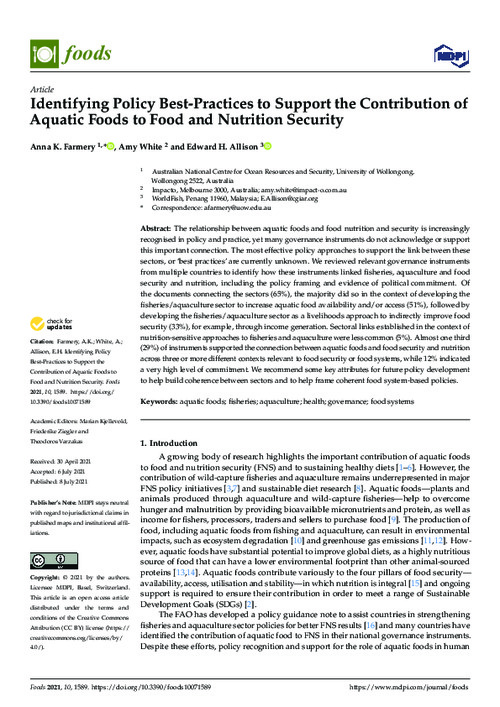Please use this identifier to cite or link to this item:
https://hdl.handle.net/20.500.12348/5258
Identifying Policy Best-Practices to Support the Contribution of Aquatic Foods to Food and Nutrition Security
| dc.creator | Farmery, A. | en_US |
| dc.creator | White, A. | en_US |
| dc.creator | Allison, E. | en_US |
| dc.date.accessioned | 2022-10-08T21:39:00Z | |
| dc.date.available | 2022-10-08T21:39:00Z | |
| dc.date.issued | 2021 | en_US |
| dc.identifier.citation | Farmery AK, White A, Allison EH. Identifying Policy Best-Practices to Support the Contribution of Aquatic Foods to Food and Nutrition Security. Foods. 2021; 10(7): 1589. https://doi.org/10.3390/foods10071589 | en_US |
| dc.identifier.issn | 2304-8158 | en_US |
| dc.identifier.uri | https://hdl.handle.net/20.500.12348/5258 | |
| dc.description.abstract | The relationship between aquatic foods and food nutrition and security is increasingly recognised in policy and practice, yet many governance instruments do not acknowledge or support this important connection. The most effective policy approaches to support the link between these sectors, or ‘best practices’ are currently unknown. We reviewed relevant governance instruments from multiple countries to identify how these instruments linked fisheries, aquaculture and food security and nutrition, including the policy framing and evidence of political commitment. Of the documents connecting the sectors (65%), the majority did so in the context of developing the fisheries/aquaculture sector to increase aquatic food availability and/or access (51%), followed by developing the fisheries/aquaculture sector as a livelihoods approach to indirectly improve food security (33%), for example, through income generation. Sectoral links established in the context of nutrition-sensitive approaches to fisheries and aquaculture were less common (5%). Almost one third (29%) of instruments supported the connection between aquatic foods and food security and nutrition across three or more different contexts relevant to food security or food systems, while 12% indicated a very high level of commitment. We recommend some key attributes for future policy development to help build coherence between sectors and to help frame coherent food system-based policies. | en_US |
| dc.format | en_US | |
| dc.language | en | en_US |
| dc.publisher | MDPI | en_US |
| dc.rights | CC-BY-4.0 | en_US |
| dc.source | Foods;(2021) | en_US |
| dc.subject | aquatic foods | en_US |
| dc.title | Identifying Policy Best-Practices to Support the Contribution of Aquatic Foods to Food and Nutrition Security | en_US |
| dc.type | Journal Article | en_US |
| cg.contributor.crp | Fish | en_US |
| cg.contributor.funder | University of Washington, Nippon Foundation Ocean Nexus Center | en_US |
| cg.coverage.region | Global | en_US |
| cg.subject.agrovoc | aquaculture | en_US |
| cg.subject.agrovoc | fisheries | en_US |
| cg.subject.agrovoc | governance | en_US |
| cg.subject.agrovoc | health | en_US |
| cg.subject.agrovoc | food systems | en_US |
| cg.contributor.affiliation | WorldFish | en_US |
| cg.contributor.affiliation | University of Wollongong | en_US |
| cg.contributor.affiliation | Impacto | en_US |
| cg.identifier.status | Open access | en_US |
| cg.identifier.ISIindexed | ISI indexed | en_US |
| cg.contribution.worldfishauthor | Allison, E. | en_US |
| cg.description.theme | Value chains and nutrition | en_US |
| cg.description.theme | Resilient small-scale fisheries | en_US |
| dc.identifier.doi | https://dx.doi.org/10.3390/foods10071589 | en_US |
